
Saturday, May 28, 2022
Temperature 66 Degrees, Overcast, Waiting for the Rain
The Mammoth Site
We discovered this museum by accident. Yet, we are so glad we not only discovered it but took the time to visit it. It is all about a time long, long ago in a land nothing like what we know today. It is about that time in our earth’s history when Mammoth’s roamed the earth. Let me take you on a brief tour.

As your enter the lobby Napoleon is there to greet you.

Now, before we enter the Bonebed some history about what we are to witness.
This is the story of an ancient sinkhole that formed during the Ice Age some 140,000 years ago and its fatal attraction for the mammoth’s and other animals of the day.

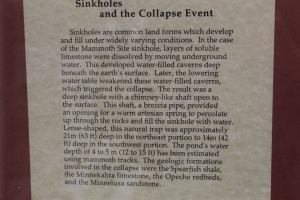
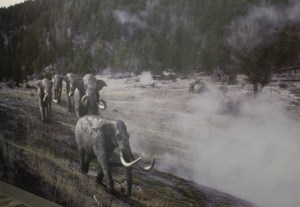
With lush vegetation growing around the rim of the sinkhole and the promise of a cool drink of water the Mammoth’s were naturally drawn to this location.
Only one problem. Once the mammoths were enticed into the pond they soon discovered that the combination of the slippery shale that made up the sides of the pond; and, the steep angle of the pond edge fatally entrapped them. Eventually they would die and their bodies would sink to the bottom of the pond. In time the pond went dry and

So, now we have a filled in sinkhole from the ice ages with who knows what captured in it just waiting to be discovered.
We jump now to 1974.
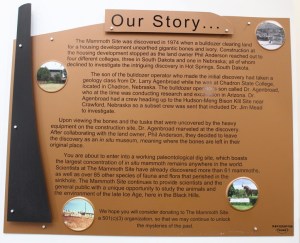
Discovered in 1974 today the site is still a working paleontological dig site. Scientists at The Mammoth Site have already discovered more than 61 mammoths. What is yet to be discovered? Well, since they still have not gotten to the bottom
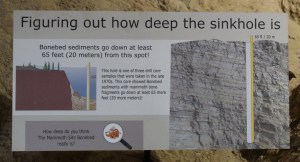
of the sinkhole there is a lot yet to be discovered. Usually, teams spend one month a year in the bonebed and then the following 11 months cleaning, cataloging and preserving what they find.
Let’s go into the bonebed.
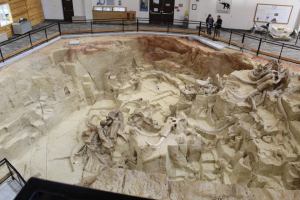
You are now looking into the deeper end of the sinkhole. Note the steep sides of the sinkhole. Standing here at the overlook you get the best view of the overall breath and depth of the sinkhole deposit.
Here in the deep end we find
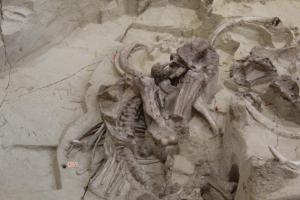
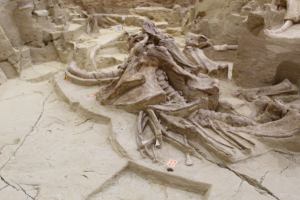
This is thought to be the most complete Columbian mammoth skeleton found so far. It is believed that he was 47 when he died.

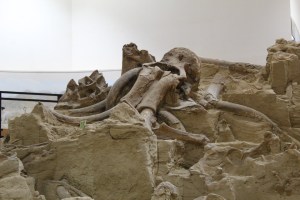
These are believed to be two of the most preserved skulls found to date. Both of these skulls are the only two that still have their tusks attached.

Flag one here at the deep end marks the actual center of the spring conduit where warm water slowly emerged into the sinkhole to create an inviting pond. If you were here in the Ice Age where these bones were just settling to the bottom of the pond you would be in the middle of a warm water pond 50 to 60 feet deep treading water, looking for a way out. Alas, the steep slippery sides at this end would prevent your exit.
Continuing,

We’re going to skip over much of what is in the middle of the sinkhole and move to the other end of it.
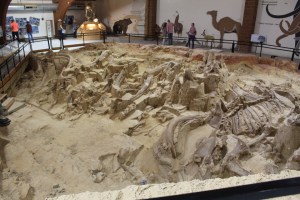
This is the far western end of the sinkhole. Note the notice of the angle of the sediment beds – they are first horizontal and then dip steeply toward the middle of the sinkhole, creating a sharp drop. This area they believe could have been where the mammoths entered the sinkhole, only to find they could not get out again. This sinkhole was truly a mammoth-selective trap.
Staying down at this end

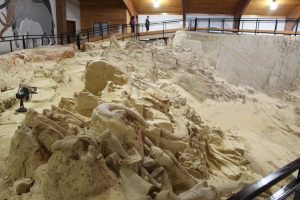
Take a look at the isolated tusks in this area. Tusks are constantly growing and are only loosely connected into the socket of a skull. Because of this, they can easily slide out of the socket while the carcass is decomposing.

Still down at the deep end.

We’re looking at the lower half of a mammoth skeleton. We can see the fan shaped hip bones. Below each is the upper leg bone.
OK, the above is just a really small selection of all that is to be discovered here at this museum. We enjoyed our time here and found it to be fascinating and a great learning experience. We both came away with a new appreciation of what life was like on our planet so many, many years ago. This is definitely a bucket list item, especially if you enjoy history or are just curious about life during the Ice Age. Hope your enjoyed our time here.
Thanks again for spending some time with us. It’s always great to be able to share our story with family and friends. Comments? Feel free to share them with me. And always remember, cherish every moment of every day that God gives you and live those moments to the fullest.
Our continuing mission remains the same: to explore as many new states as possible, to seek out new acquaintances and make new friends, to boldly go where we have not been before
This is fascinating! This is the kind of place I like to have a tour guide because there is just so much to learn, and I always am the one to ask questions. For example, why couldn’t the mammoths tell from the others stuck in the sink hole not to go take a drink? Didn’t they see the pile up, or did it happen slowly over time? It sounds like they will be excavating for a long, long time! A few years back, we visited the Waco Mammoth National Monument. I loved it! A nursery herd of Columbian Mammoth fossils is there. Another place for our bucket list. Thanks!
LikeLike
They have an excellent booklet for a self-guided tour as well as an audio app for your phone. Your question is a good one but since I’m not going back I don’t know if I can find the answer. Thanks for another bucket list attraction. Have a great weekend.
LikeLiked by 1 person
Should we make it there, I will certainly ask the question and let you know. 🙂 Enjoy your day!
LikeLike
I’d love to visit here. I’ve always been fascinated by fossils.
LikeLike